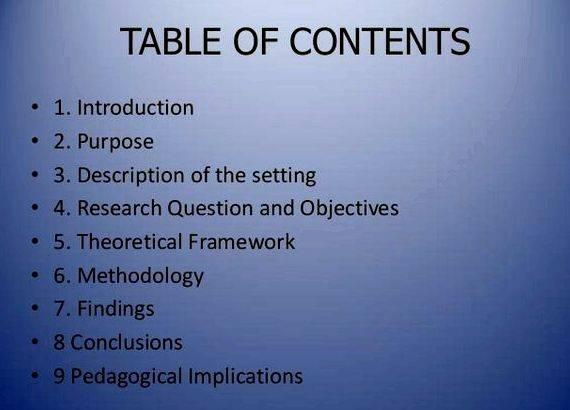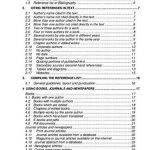Transcript and Presenter’s Notes
Title: How to write your thesis proposal
1
How to write your thesis proposal final paper
- Dr C Gabrielle Salfati
2
- These guidelines will
- Give you an example of what a proposal looks
like - Outline what goes in to each section in the
thesis - Show you how to make a logical development of a
research question - The most important thing to keep in mind is
- A thesis is a well told story, and each good
story has a good plot, which is developed
throughout the story, so STRUCTURE is key to a
well-written thesis.
3
The Research Proposal
- The first part of your thesis will be your
RESEARCH PROPOSAL. You will need to pass this in
order to continue on and complete the actual
thesis research itself. - The next section will show you what is required
in a thesis proposal, and will guide you through
how to complete it to the level required.
4
The Research Proposal
The research proposal consists of the first 4
sections
of your thesis.
- 1 page introduction to your topic
- Justify the need for your specific study by
writing a 1 page introduction to your thesis - An outline of your literature review
- What is known about topic
- What is lacking
- Show how your study aims are based on an
evaluation of the lit review - Your specific aims
- Your methodology section
- Participants and access thereof
- Data collection method
- Design of materials (questionnaire, details of
coding dictionary etc) - Analysis to be done
- Ethical considerations
- An IRB proposal if one is needed
5
An Example of a Proposal
- The following slides will give you a step by step
guide to how to complete each section of the
thesis
6
YOUNG PEOPLE WHO SEXUALLY ABUSE
- An Example of a
- Research Proposal Outline
7
Setting the scene Your 1-page introduction
What information should be included?
8
Setting the scene Your 1-page introduction
- Since the 1990s there has been a growing
awareness in the UK that children and young
people under 18 years, sexually abuse (Erooga
1999). - State the problem
- Recent research in the UK (National Childrens
Homes, 1992) has shown that this group provides
an alarming 30 of the yearly figure for all
sexual offences. - Put a figure on it
- Despite these figures, an investigation
undertaken by the Home Office (1998) into the
services for sex offenders found that the largest
and most problematic gap was in the provision for
youth sex offenders. - Reiterate the problem in light of the figures
- Sanders (1999) survey of practitioners further
highlights that most practitioners in the field
found themselves immobilised by the lack of
specific knowledge on youth sex offenders. - Put it in a practical context
9
Lit review
What information should be included?
How should it be structured?
10
Lit review
- Each main point/research highlighted in the
1-page introduction should be a separate section
in the lit review, where you go into the research
that has dealt with this point. - Include what we know (i.e what other studies have
done) and what we dont know (i.e. what issues
have not been solved satisfactorily in the
literature. Which gives you an opportunity to
use this as a justification for why you are
taking one or more of these points nad doing a
study investigating them). - The most important thing is to make sure that
- Everything that goes in, is DIRECTLY relevant to
the question (make sure you have a very specific
thesis title in order to define the issue you are
looking at it will help you be more specific in
your literature search, and will help you
structure the literature review. You can always
change it later if need be)

11
Lit review
- Start with a lead-in (a summary of what we know
and what we dont know), e.g. - Models (e.g. Finkelhor 1984 Lane and Zamora
1982) have been developed to explain adult sexual
offending. However, nothing comparable exists for
youth sex offending. Most professionals working
with young people thus find themselves adapting
models of adult sex offending in order to deal
with children, which is inappropriate and largely
ineffective.
12
- Include an overview of the models that ARE being
used (ie the adult ones) and highlight what we
can take from there to go on to develop models
for young offenders. - If there is any research on young offenders that
can be used to understand the issues better, give
a brief overview of these as well, e.g. - The research carried out so far in this area has
mainly been exploratory and descriptive.
13
- Then use this as a stepping stone to highlight to
what your project is going to deal with (aims),
e.g. - This project will involve classifying the large
heterogeneous population of youth sex
perpetrators into meaningful subgroups from
which, common factors and psychological processes
that contribute to their sexual aggression, can
be observed. This will inform practitioners about
the aetiology and developmental courses of these
young people, and will allow them to apply the
most effective and tailored treatment plans to
each group. - Make sure that this aim goes full circle to
tackle the main problem exposed in the first
paragraph which set the scene.
14
Aims
What information should be included?
15
Aims
- State the exact research aims/hypothesis in this
section - Be clear and concise
16
The Methodology Section
- This section should detail how you intend to
answer the questions you have laid out in your
aims. - You need to think about what the most appropriate
data source would be (files, people to interview
etc), and how you would access it (this is the
time to think about things like ethical approval
and IRB) - You need to think about how you will collect the
information, i.e. using a coding dictionary (a
list of variables), and interview schedule (a
list of questions), a survey etc. - You need to think about what the
advantages/disadvantages are of this data source
(e.g. is it a representative sample, is it a
biased sample, is it a small sample etc) - You need to describe your data collection method
in detail, and justify it in terms of how well it
will help you collect the necessary information
needed to answer your questions. - And finally, you need to talk about what types of
analyses is the most appropriate to do in order
to answer your aims.
17
Data
What information should be included?
18
Data
- What types of cases will be used (i.e. cases
files of young sexual abusers) - How will you access them, and have you already
made contact with the relevant agencies (i.e.
what are the chances that you will access this
information) - Why are you using the sources/agencies you are
(justification) - What are you collecting, e.g.
- Information will be collected in order to reflect
a wide range of important factors which the
interpersonal violence literature has highlighted
is important in terms of understanding sex
offending, and specifically youth sex offending.
These include - The situational factors that led to the events
- Relationships between the perpetrator and the
victim - The nature of the dynamics between the
perpetrator and the victim - The actual behavioural compositions of the
events - The characteristics of the perpetrators and
victims
19
Data Analysis
What information should be included?
20
Data Analysis
- What analysis will be done
- Why are you choosing methods you are
- How can this analysis answer your questions
21
Ethical Considerations
- State how you will deal with any ethical
issues/concerns
22
In order to pass the thesis proposal (it is a
pass or fail), the following needs to be included
- Clear research question, that is relevant and
do-able - Thorough review, and understanding, of
appropriate, most relevant literature (and any
linked literature if needed), to back research
question, and presented in a logical manner - Choice of most appropriate research methodology
for study, and thorough understanding of what is
needed in order to produce valid and reliable
study - Clear description of methodology, and thorough
research of data collection measures, linking
this clearly to the aims of the study - Appropriate selection of participant and a clear
understanding of ethical issues - Good reflection of what analysis is most
appropriate for aims and for methodology
23
You have now completed the thesis proposal
- What happens next.
24
- Once you have completed, and passed, the proposal
stage, you are then ready to do your data
collection and then your data analysis. - The tighter your proposal is, the clearer you
will be about what the main issues are to your
research, and the easier it will be for you to
complete the rest of the thesis.
25
Writing your results section
- Your results section should follow the same
structure as your aims section - which should follow the same structure of the
lit review - which should follow the same structure as the
introduction - remember structure is key to a well
written thesis!
26
- Each aim should be a separate section of your
results. - And each should start with re-iterating the aim,
and why you are looking at that aim. You should
then bring in the issues from the methodology
section which was aimed at that particular aim,
i.e. if you collected a certain number of
variables relating to this specific aim, state
that the results will focus on these variables,
and re-iterate why again.. - Then you talk about what analysis was done, and
here you re-iterate why you chose that specific
type of analysis (i.e. because it was the best
suited for what you needed to do) - Then you outline your results, using tables or
figures where necessary. - For a real-world study (versus experimental
studies where you tend to wait until the
discussion section to do this), it then makes
more sense for you to summarise the results at
the end of this section, and talk about what your
results mean (in terms of answering your aim). - Then you move on to the next aim, start a new
results section, and go through the whole process
again. - Once you have completed all the necessary
sections, you should then have one big summary
section at the end of the results section where
you highlight the key findings OVERALL.
27
The discussion/conclusion section
- The last section of your thesis is the
discussion. Here you go beyond your study, and
what you found (remember you have already
talked about this in the results section) to talk
about what the WIDER implications of your study
is to the field as a whole i.e. has your study
managed to deal with some of those key issues you
mentioned in your 1-page introduction? - By making the link to the start of your thesis,
you have now come full circle.
28
- Once you have talked about the theoretical
implications of your study, you should then talk
about - Any methodological problems you had (and that you
have identified as interfering with your
results), and how future studies may avoid them - Any further research questions that came up as
being important, and that other people in the
future may want to deal with in order to fully
explore the area - And any practical implications (if relevant) of
your theoretical results.
29
Finally
- Things not to forget to add at the end
- References (APA style)
- Any appendices
PowerShow.com is a leading presentation/slideshow sharing website. Whether your application is business, how-to, education, medicine, school, church, sales, marketing, online training or just for fun, PowerShow.com is a great resource. And, best of all, most of its cool features are free and easy to use.
You can use PowerShow.com to find and download example online PowerPoint ppt presentations on just about any topic you can imagine so you can learn how to improve your own slides and presentations for free. Or use it to find and download high-quality how-to PowerPoint ppt presentations with illustrated or animated slides that will teach you how to do something new, also for free. Or use it to upload your own PowerPoint slides so you can share them with your teachers, class, students, bosses, employees, customers, potential investors or the world. Or use it to create really cool photo slideshows – with 2D and 3D transitions, animation, and your choice of music – that you can share with your Facebook friends or Google+ circles. That’s all free as well!
For a small fee you can get the industry’s best online privacy or publicly promote your presentations and slide shows with top rankings. But aside from that it’s free. We’ll even convert your presentations and slide shows into the universal Flash format with all their original multimedia glory, including animation, 2D and 3D transition effects, embedded music or other audio, or even video embedded in slides. All for free. Most of the presentations and slideshows on PowerShow.com are free to view, many are even free to download. (You can choose whether to allow people to download your original PowerPoint presentations and photo slideshows for a fee or free or not at all.) Check out PowerShow.com today – for FREE. There is truly something for everyone!
presentations for free. Or use it to find and download high-quality how-to PowerPoint ppt presentations with illustrated or animated slides that will teach you how to do something new, also for free. Or use it to upload your own PowerPoint slides so you can share them with your teachers, class, students, bosses, employees, customers, potential investors or the world. Or use it to create really cool photo slideshows – with 2D and 3D transitions, animation, and your choice of music – that you can share with your Facebook friends or Google+ circles. That’s all free as well!
For a small fee you can get the industry’s best online privacy or publicly promote your presentations and slide shows with top rankings. But aside from that it’s free. We’ll even convert your presentations and slide shows into the universal Flash format with all their original multimedia glory, including animation, 2D and 3D transition effects, embedded music or other audio, or even video embedded in slides. All for free. Most of the presentations and slideshows on PowerShow.com are free to view, many are even free to download. (You can choose whether to allow people to download your original PowerPoint presentations and photo slideshows for a fee or free or not at all.) Check out PowerShow.com today – for FREE. There is truly something for everyone!




 Quantum dot infrared photodetector thesis proposal
Quantum dot infrared photodetector thesis proposal Iit madras phd thesis proposal
Iit madras phd thesis proposal Financial mathematics phd thesis proposal
Financial mathematics phd thesis proposal List of publications in thesis proposal
List of publications in thesis proposal Referencing figures in dissertation proposal
Referencing figures in dissertation proposal






